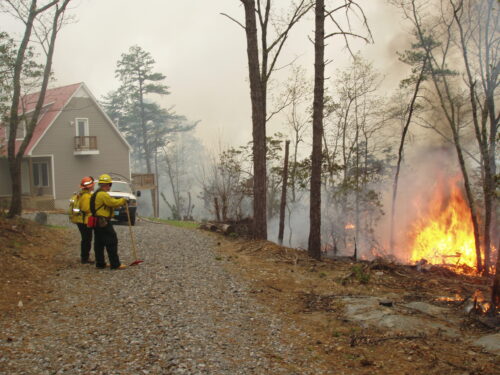 Living in a woodland community requires careful planning to protect homes and property from wildfires. Learn how to live safely in the wildland/urban interface area by becoming a Firewise Community.
Living in a woodland community requires careful planning to protect homes and property from wildfires. Learn how to live safely in the wildland/urban interface area by becoming a Firewise Community.
During the past century, the United States population has nearly tripled, with much of the growth flowing into traditionally natural areas. This trend has created an extremely complex landscape known as the wildland-urban interface. Encroaching development into forests, grasslands, and farms has put lives, property, and natural resources at risk from wildfire.
Living in a house surrounded by nature and woodlands can be peaceful and beautiful, but it can also be risky. Many newly rural residents bring with them a “back-to-nature” philosophy that leads them to leave the property around them as undisturbed as possible. This mindset often leads to insufficient access roads and hazardous fuel conditions very close to homes, creating a dangerous situation for the homeowners and firefighters in the event of a wildfire. Unfortunately, once a wildfire ignites, firefighters are limited in what they can do to protect valuables in its path.
Learn more about the becoming a Firewise Community.
Take action now to make your community Firewise.
Financial assistance may be available for hazard mitigation through the Firewise Virginia Community Hazard Mitigation Grant Program.
Additional Resources
For additional information about the Firewise Communities/USA program, view the National Fire Protection Association’s Frequently Asked Questions.
| Image | Title | ID | Description | Content Type | View | hf:tax:document-category | hf:tax:Media |
|---|---|---|---|---|---|---|---|
| Fire Adaptive Landscaping for Native Habitats and Wildlife in the Southern Coastal Plain | Book was prepared by the Georgia Forestry Commission, U.S. Fish and Wildlife Service, Coastal Wildscapes, and Firewise Communities to provide every resident and business owner has the opportunity to enhance wildlife habitat and natural ecological systems by maintaining, or where necessary, restoring connectivity to the surrounding forests and other natural communities through landscaping and gardening activities. They can also address the very important issues of water conservation and loss of habitat from invasive species by using native plants and avoiding exotic plants when deciding what to plant. We invite all coastal plain individuals and communities to emphasize creative solutions to protect native habitats and wildlife while connecting with nature and achieving Firewise principals. This publication was created to give everyday people and everyday businesses guidelines for landscaping with these goals in mind. | Publication | View | fire-and-emergency-response urban-and-community-forestry | publication | ||
| Firewise Communities for Virginia | P00111 | Brochure provides important steps to protecting your home and community from wildfire, including firewise landscaping, defensible space, fire-resistant roof and exterior construction, fire-resistant attachments, steps to becoming a firewise community, a disaster plan, defensible space, and emergency access. Printed copies available. | Publication | View | fire-and-emergency-response | publication | |
| Firewise Landscaping Part 1: Overview | Video | View | fire-and-emergency-response | video | |||
| Firewise Landscaping Part 2: Design and Installation | Video | View | fire-and-emergency-response | video | |||
| Firewise Landscaping Part 3: Maintenance | Video | View | fire-and-emergency-response | video | |||
 | Home Wildfire Safety Checklist – Is Your Home Firewise? | FT0002 | Forestry topic information sheet provides a checklist of items to answer about your home to assist in identifying characteristics of your home that may require changes to improve the wildfire safety of your home. | Publication | View | fire-and-emergency-response | publication |
 | Is Your Home Safe from a Wildfire | Publication | View | fire-and-emergency-response | publication |
Contact Us
For more information or questions, e-mail us or use our contact form.
